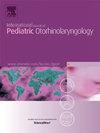Children with a tracheostomy: Global speech-language therapists' practice
IF 1.2
4区 医学
Q3 OTORHINOLARYNGOLOGY
International journal of pediatric otorhinolaryngology
Pub Date : 2025-02-01
DOI:10.1016/j.ijporl.2025.112237
引用次数: 0
Abstract
Purpose
Speech-language Therapists (SLTs) are specialists in communication, feeding and swallowing as core members of the paediatric tracheostomy multidisciplinary team (MDT). Inconsistent tracheostomy care leads to staff and family frustration and delayed intervention. Little is known about international SLT tracheostomy practices.
Methods
This global survey explored training, clinical practices, perceived knowledge, skills and roles, and barriers for SLTs working with paediatric tracheostomy. Survey questions consisted of Likert scale and open-ended questions. 92 SLTs completed the survey representing 6 continents and 19 countries.
Results
Overall SLTs were confident in their knowledge of communication, and feeding but less confident in weaning, tracheostomy care skills (such as suctioning and cuff deflation) and specialist tracheostomy tube use (such as tracheostomy tubes with a subglottic suction port). Formal competency training was infrequent but most had access to supervision. Understanding of the SLT role by the MDT was perceived as good. Many felt managing one-way speaking valves was part of their role. The majority reported staffing, lack of guidelines and access to resources (one-way speaking valves and flexible endoscopic evaluation of swallowing) as barriers.
Conclusions
This expert opinion paper summarises the current evidence-base and international paediatric tracheostomy practice. SLTs were experienced and confident in tracheostomy. The SLT role varies internationally with a lack of formal written policy to guide practice and a variability in access to education.
求助全文
约1分钟内获得全文
求助全文
来源期刊
CiteScore
3.20
自引率
6.70%
发文量
276
审稿时长
62 days
期刊介绍:
The purpose of the International Journal of Pediatric Otorhinolaryngology is to concentrate and disseminate information concerning prevention, cure and care of otorhinolaryngological disorders in infants and children due to developmental, degenerative, infectious, neoplastic, traumatic, social, psychiatric and economic causes. The Journal provides a medium for clinical and basic contributions in all of the areas of pediatric otorhinolaryngology. This includes medical and surgical otology, bronchoesophagology, laryngology, rhinology, diseases of the head and neck, and disorders of communication, including voice, speech and language disorders.

 求助内容:
求助内容: 应助结果提醒方式:
应助结果提醒方式:


